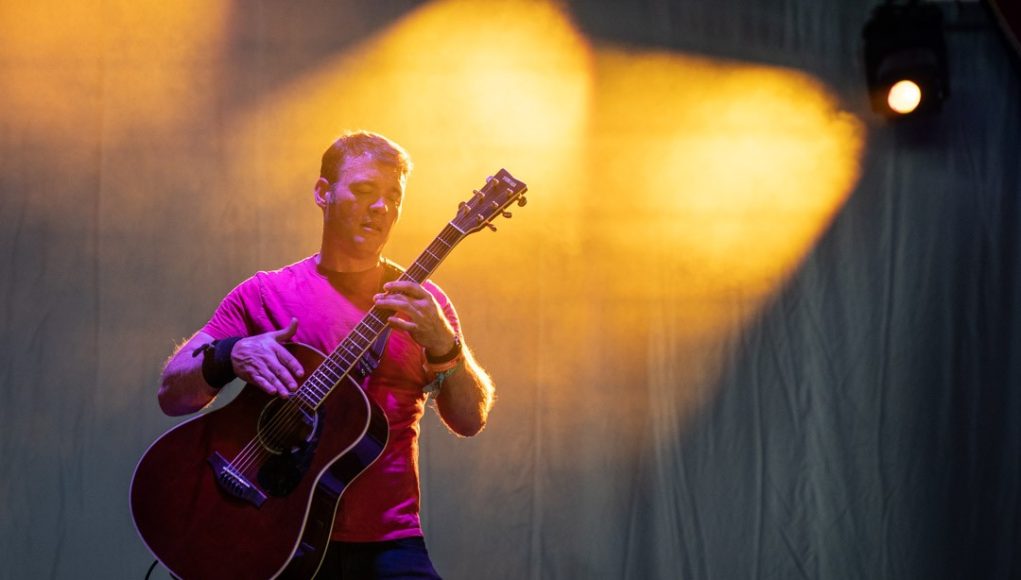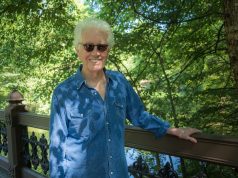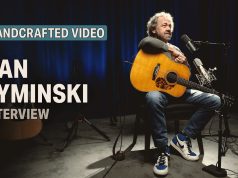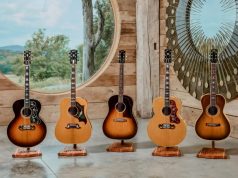Your music is known as ‘Full Contact Folk Music’ I wonder how that label came about?
Yeah, that was from a gig back when I was living in Texas. I was performing the Flip Trick, and it didn’t go right. I ended up hitting myself in the face with one of my acoustics. It was a hard knock, I kinda blacked out for a second, and ended up landing on the chair, and coming to, and carrying on as though it didn’t happen. The mechanics of the trick are all automatic now, I’ve done it so many times, and I guess I dropped the guitar a little further than I meant to and I bent my head further forward, and it ended up where the guitar was coming up and I wacked myself pretty good! I thought I got away with it, but I ended up bleeding out of my eye, but I was fine. After the show, someone came up to me and said “Rodney, that was full contact folk music!” and I thought that was a great description, kinda like ‘musical rugby’!
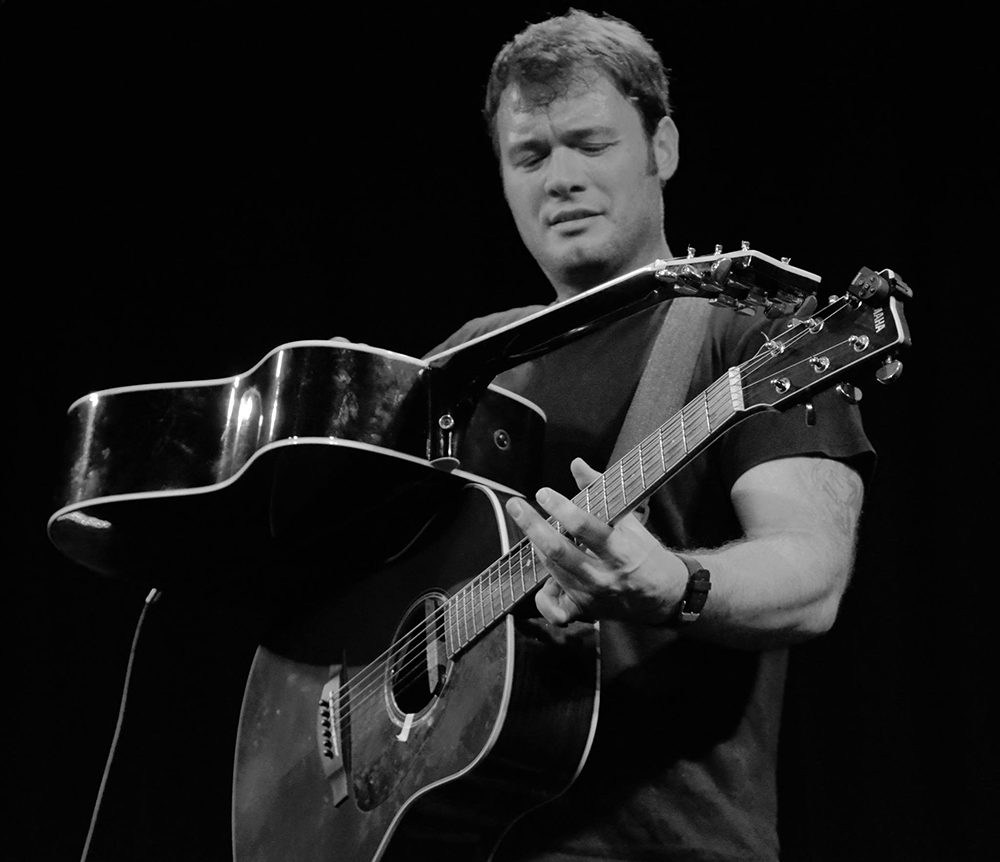
For the benefit of anyone who has not seen you play live, can you explain what the Flip Trick is, and how it came to be a part of your shows?
Well, I had already got the technique of playing two guitars at the same time, by balancing one on top of the standard guitar, I was playing a show in Colorado, up in the mountains, about eight thousand feet up. I was really drunk, and I hit on the idea of laying one guitar flat on top of the guitar I was playing, holding it in place with elbow, and playing the two together. Then I walked over to the in-house drum kit and started playing the kick drum with one foot, and the tambourine with the other foot. Then I just got a little light-headed, and I fell over the kick drum and dropped the second guitar, but I managed to catch it. I thought it was cool, so I got back to my teaching studio that I had in Amarillo at the time, and just practised it over and over again until I could do it. It’s all about spectacle, it’s like playing a guitar behind your head, that sort of thing. I like to do the unexpected, and when people haven’t seen me before, I can see in their faces when I play the two guitars, they wonder what’s going on, and when I drop the guitar and catch it, they think I messed up and then they realise that it’s deliberate, and that’s really cool. I’m all for any way you can reach out to an audience and communicate by doing something a little different.
Your guitar hero when you were growing up was Stevie Ray Vaughan, so I’m curious why you didn’t follow the electric guitar route, as opposed to the acoustic and Americana music that you play.
I did initially follow the electric route when I first got involved in bands. I joined a power trio playing electric guitar, which was pretty much what everyone was doing in Texas at that time. I graduated from high school in 1995, and just went out on the scene as a guitar player. I fronted a couple of three-piece bands, but they never took off. Part of the reason was, I think, was that the area was just saturated with bands with that set-up. So, I started putting more effort into my acoustic shows – I was playing those as well, just playing café gigs as a solo player. I found that that aspect of my career was proving to be more successful so it was easy enough to go out on the road on my own, I didn’t have to worry about other musicians, or carrying a load of gear around with me. That’s what I did, and the rest as they say is history. I still have around a thousand cassettes from the twelve hundred we had pressed with my first band, a blues trio. They are all still in storage at my dad’s house. I have done some band shows as an acoustic player, but the logistics are a lot more complicated. You have to plan multiple hotel rooms, and daily rates and expenses for people. It’s just so much easier to put my acoustic in the car and drive to Heathrow and get a flight to wherever I am playing. The simplicity of that is much better to deal with.
Do you still have your large fan base in India?
I do yes, although I haven’t been back to play over there since lockdown. I was due to go out on a big tour in 2020, we had two-hundred-and-ten shows booked, I was going back to India, and then to Australia and then on to South America, I’ve never been to South America before, then some American dates, and then South Africa, but of course lockdown happened, and I had to get a day job.
You have collaborated for a number of writing projects – how do you approach working with other people, do you take the same approach with everyone, or do you adapt depending who are working with?
Well, I used to consider myself a full-time writer, but I started a day job when lockdown stopped everything. Since my day job has taken more time, I haven’t had the time to work with anyone just lately. I do like to write every day if I can, I love writing melodies, it’s the lyrics that I am not as strong with, it’s something I have to work very hard on. Usually, I am looking for someone who can work on what I am doing musically, and then do the same thing lyrically. I’m not really looking for someone to add to the musicality of what I do, I just feel I am a little in need of some lyrical input. I probably shouldn’t feel that way, but it is what I feel I need. I look for collaborators that play to my strengths, which is the essence of collaboration in any area of creativity.
What was your day job?
I invented a light fixture that reduces pathogen transmissions, and I patented it, and I was able to get funding to create a workshop and build a prototype. I am connected to Texas University’s Tech programme, and they have provided resources, I have engineering interns who are doing mathematical calculations for me. I am writing a White Paper because I have managed to adapt a medical application and make it a commercial application. Covid threw me a big loop, like it did for everyone, but I was an engineering student and I dropped out to record my first acoustic album, as part of a gap year. When Covid hit, I wasn’t able to make any money as a musician, so I contacted some guys I was at school with, and they were able to get us some research grant funding, and now the project is moving forward.
You did carry on some writing during Covid, was your songwriting affected by the limitations of lockdown?
I found it hard to write on acoustic during the lockdown, so I found myself writing on piano and bass guitar. So now I have a looper that I use to loop the bass parts, and then I play and sing over that. I think it was as much about feeling depressed as anything. I still needed a creative outlet. Before Covid hit I was just full of momentum, I opened for Tommy Emmanuel at Celtic Connections and I had Main Stage festival gigs booked, and then just to have all that taken away was really hard. When I picked up the guitar, I felt … disappointed in it, so that’s when I switched to piano and bass. I enjoy vocal looping, it’s really good fun. I’ve just started doing that last year on shows. I am avoiding using loops on my guitar playing, I feel that maybe it distracts people when I play without it, they will be waiting for it to come in.
What was your first acoustic guitar?
Well, my dad was a musician, so I inherited most of the guitars I had growing up. I had an Ibanez, one of the Artist Series, made in about 1979. It was an awful guitar to be honest. The action was really heavy, it played like an electric. My dad used to play it in a country band he was in. I got a Stratocaster from my dad when I was about thirteen, he stopped playing in country bands so he didn’t need the Strat and he passed it on to me. I fell in love with that, getting that guitar was a life-changer for me. My first acoustic was a Seagull, I had it as my High School graduation present. It was an inexpensive model, I think once I started touring, I got through about four n of them! And two Larrivees as well, and then I had another three Seagulls. I don’t take any of my really expensive guitars out on the road because I have had so many get damaged out on tour. I have some Yamahas that are part of my endorsement deal with them. I have two Yamaha LL16 guitars, and a Yamaha LL26C, and a couple of the Yamaha A models, the ones that flip well! They have great balance, and they flip really well if they throw one in the air. Don’t try it with a Guild Jumbo, they are really hard to get airborne!
Do you use any particular tunings?
Not really. I tend to use standard tunings and occasionally C and sometimes D. I don’t like to take out time in shows to re-tune my guitars, so I tend to write everything in the keys I can use easily. I usually take out three guitars, I keep two in standard tuning, and one tuned in C. That means I can change the guitars nice and quickly. Tuning is necessary, but it’s less than exciting for an audience to wait while you do it. It’s Ok if you are in London and you have a nice easy-going audience, but if you are on a festival stage, you haven’t got time to hang around, you have to maintain people’s attention.
What about effects?
No, I’m pretty much a straight-down-the-line player. I was endorsed by TC Electronics, and they gave me their G-Natural effects processor to try out. It was a prototype, and it died on the second or third gig I had it, probably because it was a prototype. But now I just like things nice and simple, just pack my guitars in the car and go. I started using a Vocal Processor, that takes up any room I have to carry.
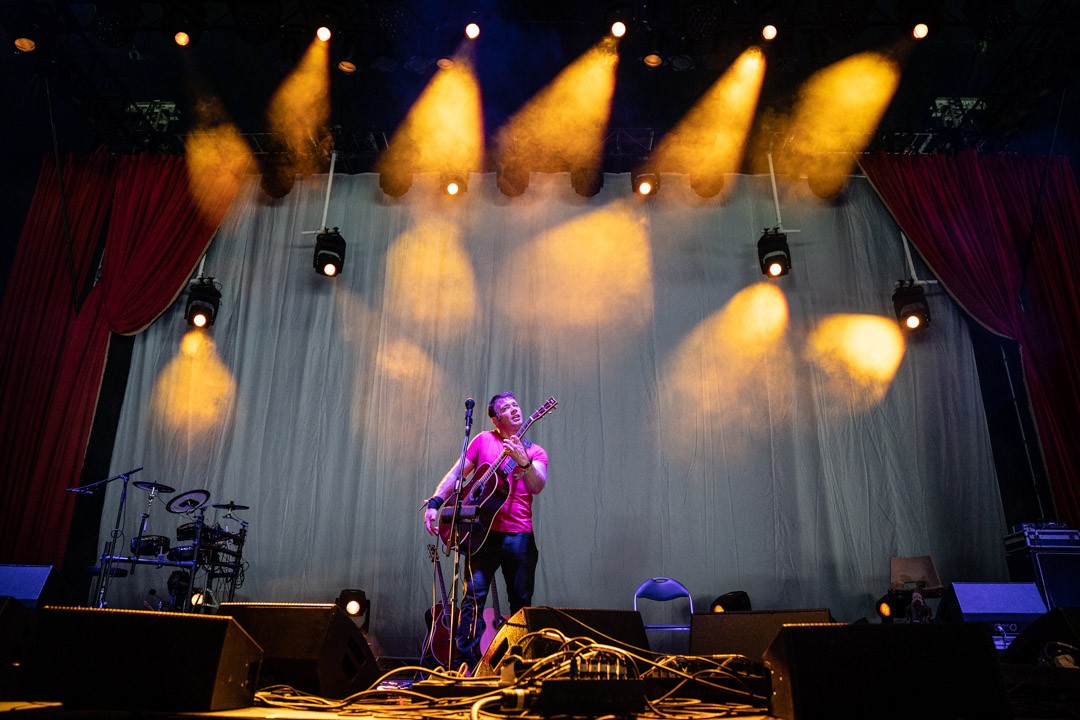
What is your favourite part of your live show?
I’ve really got into playing the piano and the bass guitar. I’ve always used them in the studio, when I’ve been messing around in the studio, or writing. I am in love with bass lines, I can see myself in a band just thumping away there holding down that bottom end, I love it.
Do you feel that your acoustic technique is where you want it to be, or are you still developing new playing styles?
I’m still constantly learning stuff. I have been trying out some different styles in the writing I’ve been doing since lockdown ended. I am trying a technique of playing the guitar behind my back, so I’m not looking at it. It’s a bit more spectacle. It’s not that impressive technically, but it looks cool. It’s all about making the spectacle look casual. I am always looking at other players and seeing what looks cool, and what I can maybe adapt into what I do. Working with Tommy Emmanuel was amazing from that point of view. I’d never seen him play live before, just some videos, but what a player, he is wonderful.
Have you ever had a bespoke model made for you?
I would love a guitar designed for me, especially the electronics. I am using Fishman Rare Earth at the moment. I am experimenting with some electronics at home, but nothing I’m ready to try out with an audience yet. It’s a lot harder than it looks! I am looking to get some weight off the guitar. If you put a couple of pickups in, it does increase the weight of the guitar. It doesn’t reach Les Paul levels of weight, but I am looking for a passive system that will work the way I want it to. I want to get batteries out of the guitar, that is what I’m working on right now. For me, the pickup system is the most important thing for a live acoustic show. If you have a good pickup, you can use pretty much any guitar, it doesn’t have to be expensive. Mostly the audience is not aware of how expensive an acoustic guitar is when it’s played, as long as the sound is clear, that’s what’s important. If I was having a guitar made, I would want to get the best pickup system I could, and also a nice light body with throwing-in-the-air capacity included!
Do you have any advice for acoustic players?
Sure, what I always tell players when I deliver a masterclass is, it’s important to practice to a level where you don’t need to look down at your hands, or at the guitar to see where your next chord is. the reason for that is, when you are performing a concert, you need to make eye contact with your audience. We are entertainers, and you need to build that rapport with your audience, and if you are staring down at your guitar the whole time, you are never going to make that connection. Know you are an entertainer, and you have to entertain. It’s quite a step to take the focus on your technique that you need to have to be able to play live for a paying audience, and then making that technique automatic, so you can concentrate on connecting with the people. That is a valuable lesson, and I pass it on whenever I am asked about advice. Noy everyone in your audience is a guitar player, and understands and appreciates the skill you are using to play. But everyone is an audience member, and they will all understand the communication you set up, which is why it is so important to be able to do that.
What’s next for you?
Well, I have been concentrating on my day job for a while, but I am getting back into some writing. I have a three-day session in Sweden at the studio of a producer called Amir Aly. He has contributed to some of the Swedish entries for the Eurovision Song Contest, and we are going to be trying some writing together. We’ll see what emerges from that. In terms of live playing, I am looking at expanding my audiences in Europe, I’m off to Spain at the beginning of October. I have just played some shows in Eastern Europe, and they were phenomenal, so I concentrating on working over there to build things up.
ANDY HUGHES.


